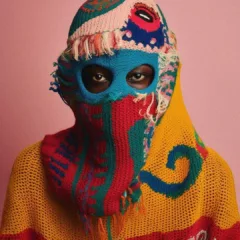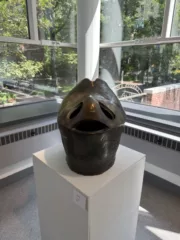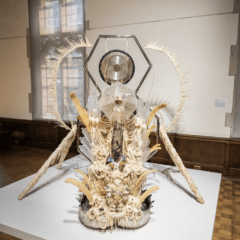
Documenta 12 artistic director Roger Buergel and curator Ruth Noack.
Photo by Marianne Menke
Documenta 12 artistic director Roger M. Buergel came to town, Thursday, and it was an Ascot moment. Everyone who should be there was there. The talk on a seemingly abstruse subject–Migration of Form–attracted local curators and art lovers, from Julie Courtney to Anabelle Rodriguez. People desperate for seats first sat in the aisles and then stood in the little space that was left at a lecture room at the University of Pennsylvania.
Buergel turned out to be a slight, Euro/intellectual looking guy with short-short hair, sporting a dark pink henley-neckline knit shirt tucked into slightly offbeat camel plaid trousers that referenced the ubiquitous Burberry plaid and then got far far beyond it. His clothes reflected the man–an intellectual with an informal mien and a sense of humor.
According to the introduction, Buergel was trained in philosophy, economics and contemporary art, and he was an artist (can one be an ex-artist?). This background makes him just the man for an exhibit that requires a grasp of budgets, a knowledge of contemporary art, and some sort of philosophical approach to make sense of the project. Documenta 12 is due to open in Kassel, Germany, in June.
As artistic director, Buergel said, he was immediately confronted with what standards he would use, what concepts, on which to base his selection of contributors to the exhibit. “The only curatorial method I can think of is improvisation.”
Political contexts
Buergel decided that Documenta was inextricably linked to its history.
Part of a government-created fair, the Federal Garden Show, for a society that was busy reinventing itself and its values after World War II, Documenta 1 used the space inside the bombed museum in Kassel, a museum that had been the first public museum on the European continent.
“Using the space as a ruin was loaded,” Buergel said. Germans had been propagandized into believing that modern art was degenerate art, yet here was modern art being presented on the ruins of that German past. And the Federal Garden Show was presented on a hill made from WWII rubble.
Documenta 1, in 1955 was conceived as a single event, not to be repeated. Of course it was. After all, we’re up to number 12. But it is the history of Documenta 1–establishing and teaching a new code of values to a mass audience–that is behind Buergel’s own version.
Because Documenta 12 will show art from multiple contexts, multiple countries around the globe, Buergel has been trying to figure out how to make unfamiliar art meaningful in the context of the German history of Kassel. “I can’t give the audience large texts to read,” he said. He showed an example of a montage from an Indian artist whose imagery of an arm emerging from water was meaningful across cultures thanks to a Grimm’s fairy tale, the Willful Child, about a child who wouldn’t stay buried.

Design for Crystal Palace, the tongue-in-cheek name for the plastic sheeting pavilion
by Lacaton & Vassal, Montage: Tim Hupe Architekten © documenta GmbH
He said he had to also take into account how people are accustomed to looking at art and how they are accustomed to looking at a mass exhibit–“run through, see everything, make discoveries and arrive at a judgment. …Our idea,” he said, “is to seduce people to relax and take a closer look.”
With that in mind and no budget, the pavilion for 2/3 of the art exhibit looks a lot like a garden nursery, with plastic sheeting stretched over arching metal frames.
Art for the people
To attract the locals to the exhibit, Buergel arranged for trainees in a local factory to manufacture 10 multiples of a sculpture, funny what-is-it tub-like things. Buergel then created a sort of adopt-a-sculpture program in which people in the town took turns caring for the sculptures. His hope is this will break down the barriers and bring lay people into the art space. The audience he is aiming at include all of Kassel’s population, including the Russians (10 percent of the population) who still don’t speak German, and the many second-generation Turkish population.
He said the show couldn’t reproduce the contexts from which the art came, but the exhibit’s job is to provide new, meaningful contexts. His hope is that the art works communicate with each other, and that the viewers will be sucked in, with the unfolding exhibit working sequentially like a film and encouraging comparisons in the homey garden-house pavilion.
His goal, he said, is mass intellectuality.
Next Sachs Forum talk
The talk by the way was part of the Sachs Forums, this year organized by Richard Meyer in collaboration with the ICA, etc. etc. The next talk is Way Out On A Nut, thu feb 1 @ 5:30pm, in which Douglas Crimp crosses memories of his “two first jobs in New York,” working as a curatorial assistant at the Guggenheim Museum and an assistant to the fashion designer Charles James. Buergel spoke at Logan Hall, and I would guess so will Crimp. But you’ll have to call or email the ICA to check. The web site doesn’t say.









